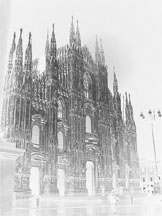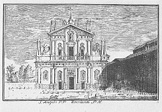Discovering the Spanish bastions, the Leonardesque locks and the "itinerants" churches
The Spanish bastions symbolize a military and cultural occupation long past which, along with the Leonardesque basins and the "itinerants" churches, still represent this area of the city of Milan.
Corso Como
This avenue with its pubs, discos and bars, is one of the hot spot for the nightlife in Milan.
Corso Como is situated on the north side of Milan and at one end is the Porta Garibaldi Railway Station and the underground green line M2. The most "posh" and fashionable discos are: the Hollywood, the famous disco in Milan, the Gasoline located in the near Bonnet street and the Toqueville the same street. At the north end of Como Avenue will raise a "Fashion citadel" that will become a new worldwide fashion centre. The most famous bars of this area are Corso Como 10, located in an ancient courtyard and numerous, small venues appearing directly on the street such as the PitBull, the Pixel and Caffé Novecento.
Garibaldi city Gate Milan
Once called Comasina city Gate, it was built by architect Giacomo Moraglia when the Spanish bastion lost their defensive importance. On 22 March 1848, during the insurrection against the Austrian Empire, it was the second city Gate taken by the rebellious after Tosa city Gate.
"Cucine Economiche"
An eclectic building opened in 1883 by Luigi Broggi with the purpose to host the "Promoting Committee for Cucine Economiche and Social/Corporate Ovens". Nearby it is possible to admire buildings with wrought iron Art Nouveau decorations.
Tombone di San Marco - San Marco Lock
In the middle of the 15th century a system of locks was built to allow the communications between basins of different levels. Leonardo da Vinci projected the San Marco Lock between 1506 and 1513. The purpose of this project was to connect, through two locks (San Marco and Incoronata), the Martesana waterway with the other internal waterways; the realization of this project made it possible to cross the city by water and it also connects the river Adda with the river Ticino.
A Leonardo da Vinci’s original idea was to build the lower hatch, manoeuvrable from the hawser, to allow water to come in and out.
Church of Santa Maria Incoronata
The church is composed of two twin churches like those of San Cristoforo al Naviglio or the famous churches of Piazza del Popolo in Rome. The older of the two churches is the one on the left hand side (watching from the parvis) and was built during the communes age, by the Hermit Fathers of San Marco and consecrated to Santa Maria di Garegnano. At the beginning of the XV century a convent of the Augustinian Fathers was built; the order restored the church with late gothic style; the church was finished for the occasion of the coronation of Francesco Sforza duke of Milan in 1451 and was consecrated to Santa Maria Incoronata in honour of the duke. As per Bianca Maria Lady of Cremona wishes, an exact replica of the church was built nine years later; the church was connected to the first one and became the symbol of the union between the duke and the Lady of Cremona.
Basilica of San Simpliciano
The basilica was one of the first churches to be erected in Milan. It was Saint Ambrose who commissioned it (4th century) and it was then completed under his successor Saint Simpliciano, who was buried there. During the year 398, the basilica also welcomed the relics of three martyrs: Sisinio, Martirio and Alessandro. From the 4th century a.d. to date, the structures of the church were subject to many transformations, the most significant ones of which are those of the 7th and 11th centuries. On the inside, in the basin of the apse, is the large Coronation of Mary, a fresco by Bergognone. The church is associated with the memory of the battle of Legnano: the windows on the facade illustrate the "Glories of the Carroccio".
Church of Saint Angelo
The church was constructed in the mid-16th century by the Spanish general and Governor Milan Ferrante Gonzaga, over an edifice already existing in 1418, in replacement of the eponymous one, which had been destroyed to build the new walls. The design was by Domenico Giunti. The small bell tower is from 1607, while the façade was finished only in 1630, in late-Mannerist style. The church is one of the few in Milan which has not been restored in "neo-medieval" style during the 19th century. It has a single nave with side chapels and barrel vault, a transept and a deep presbytery. Artworks include works by Gaudenzio Ferrari (chapel of St. Catherine, now replaced by a copy; the original is in the Pinacoteca di Brera). The triumphal arch has a frescoes with a solemn Incoronation of Mary by Stefano Maria Legnani (Legnanino).
|














